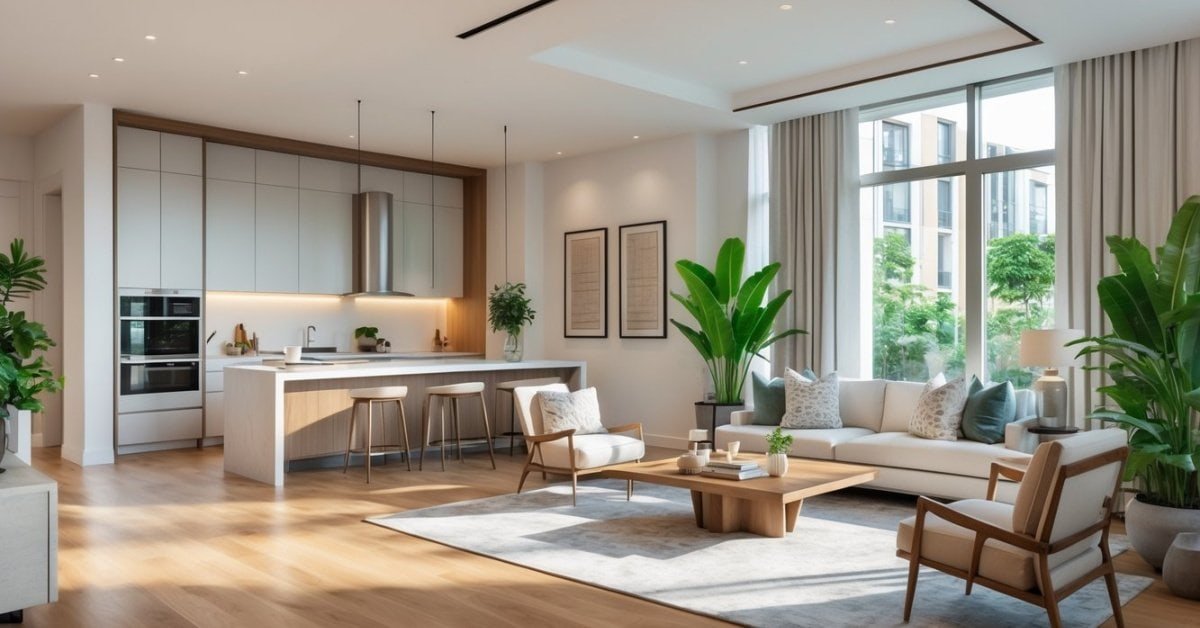Key Takeaways
- Assess your space thoroughly to identify storage needs, unused areas, and optimal layout for traffic flow and functionality.
- Declutter regularly by prioritizing everyday essentials and removing or relocating rarely-used items and single-purpose gadgets.
- Maximize storage with pull-out shelves, wall-mounted racks, drawer dividers, and by utilizing vertical spaces such as walls and cabinet tops.
- Organize by creating functional zones for cooking, cleaning, and storage, and maintain order with clear labeling and routine resets.
- Invest in space-saving tools like stackable containers, drawer organizers, and multi-functional appliances to make the most of limited space.
- Maintain organization long-term through weekly tidy-ups, monthly decluttering, and adapting systems as your habits or kitchen needs change.
Living in a small apartment means every inch counts especially in the kitchen. I know how frustrating it feels to dig through cluttered drawers or search for that one pan buried behind a mountain of pots. A tiny kitchen can quickly turn chaotic but it doesn’t have to stay that way.
With a few clever tricks and a bit of creativity I’ve learned it’s possible to make even the tiniest kitchen feel open and efficient. When everything has its place cooking and cleaning become so much easier—and a lot more fun. Let me share how I turned my cramped kitchen into a space that works for me not against me.
Assessing Your Small Apartment Kitchen
Seeing the real layout of your small apartment kitchen always comes first for me when I’m ready to update or reorganize. I start by measuring every wall, cabinet, and appliance. Getting exact numbers helps me plan custom solutions—like narrow pull-out shelves or wall-mounted racks—so each inch pulls its weight.
Evaluating storage always matters. I count every cabinet, drawer, and open shelf, and note unused vertical space above upper cabinets or on blank walls. Open spaces near the ceiling, under the sink, or behind doors can turn into new storage with the right rack or organizer.
Traffic flow lets me spot obstacles. I walk through the kitchen, simulating cooking and cleaning with someone else sharing the space. Doors that bump into counters, tight walkways, and inaccessible drawers often need attention for a smooth workflow.
Lighting and outlets play big roles, too. I note where shadows fall across prep areas and which outlets are easiest to reach for appliances like toasters or blenders. Brightening up dark spots or adding a pop-up outlet can upgrade function for everyday tasks.
Listing what actually gets used redirects space for the right elements. I pull out every pot, pan, gadget, and container, then sort rarely-used items to free up prime spots for everyday essentials. This lets my team and I tailor every solution to real habits, not just pretty arrangements.
Careful assessment never skips these steps, because in a small kitchen, thoughtful planning outshines guesswork every single time.
Decluttering and Prioritizing Essentials
Every square inch counts in a small apartment kitchen, so I focus on streamlining what stays. My goal is to clear space for essentials and keep daily routines efficient, drawing from years spent redesigning tight layouts.
Sorting Items by Frequency of Use
I always sort kitchen items by how often I reach for them. Everyday cookware like frying pans, chef’s knives, coffee mugs, and cutting boards go in the most accessible spots—cabinet fronts, open shelves, or by the stove. Rarely used items such as holiday platters or specialty bakeware shift to upper cabinets or even outside the kitchen. I recommend labeling storage bins or shelves, especially when stashing non-daily tools, to save time and avoid hunt-and-peck frustration.
Letting Go of Unnecessary Gadgets
I’ve learned to be ruthless with countertop appliances and single-use gadgets. If a tool hasn’t seen action in the last six months (for example, a fondue pot or waffle iron), I remove it from the kitchen—donate, sell, or store it offsite in a closet. I keep quality over quantity in mind; a multipurpose blender, a single Dutch oven, and sharp knives handle most kitchen challenges in small spaces. Each time I clear out duplicates and rarely-used gadgets, daily prep feels easier and the space looks bigger.
By focusing on essentials and letting go of extras, I’ve helped countless clients maximize even the tiniest kitchen spaces.
Maximizing Storage Space
I’ve worked in dozens of small apartment kitchens, and I’ve seen how smart storage changes day-to-day cooking. Using every inch—inside cabinets, above countertops, on the walls—brings function to even the tightest layouts.
Creative Cabinet and Drawer Solutions
Pull-out shelves in lower cabinets add easy access for heavy pots and pans. I often install slim pull-out racks beside the stove or fridge to stash oils and spices—Cabico and Rev-A-Shelf carry models under 6″ wide. Drawer dividers keep utensils, knives, and gadgets sorted instead of tangled in a jumble. If cabinets reach the ceiling, I use the top shelf for items I rarely use, like the big turkey roaster or seasonal baking dishes. For narrow drawers, vertical tray dividers create upright storage for cutting boards and baking sheets.
Utilizing Wall and Vertical Space
Wall-mounted rails and magnetic strips free up counters and drawers. I install rails with S-hooks to hang utensils or baskets for produce—a solution that IKEA and OXO both offer. Pegboards turn empty walls into storage, letting me rearrange tools based on my weekly meal plans. Open shelves mounted high along the wall keep glassware or cookbooks on display but out of the way. Over-cabinet hooks and racks add storage for pot lids or cleaning supplies on door interiors. For renters, adhesive hooks or portable trolleys add extra space without permanent changes.
Smart Organization Strategies
Small apartment kitchens can feel twice as large with a smart layout and a focused strategy. I always look for practical ways to transform tight spaces into efficient work zones that actually make cooking and cleaning easier.
Zones for Cooking, Cleaning, and Storage
Creating distinct zones helps every inch work harder. I group items by function, placing all prep tools near the main workspace, cleaning essentials under the sink, and food storage containers close to where I unload groceries. For example, I make sure cutting boards, knives, and mixing bowls stay near the counter I use most. I keep soaps, scrubbers, and dish towels under the sink or mounted on cabinet doors with racks and caddies. I use deep drawers or upper cabinets to hold dry goods and meal prep containers, freeing up counters for daily use. I always think about flow, making sure pathways stay clear by grouping storage out of high-traffic areas.
Labeling and Maintaining Order
Labels add clarity and save time during busy routines. I print or handwrite clear labels for bins, jars, and baskets, so I never waste time searching for the right spice or snack. Color-coded labels work best for families; for example, green for snacks, blue for baking ingredients. I always place labels at eye level for quick scanning. When I flip spaces, I teach new owners to reset zones monthly, putting stray items back where they belong. Quick daily tidy-ups keep the whole kitchen organized, and that consistency maintains efficiency for the long haul.
Incorporating Space-Saving Tools and Accessories
In small apartment kitchens, I’ve learned that the right accessories make every square inch count. Over countless flips, space-saving tools have helped me turn cramped kitchens into organized, efficient workspaces.
Stackable Containers and Drawer Organizers
Stackable containers simplify storing dry goods, snacks, or baking supplies in upper cabinets and deep shelves. I always recommend clear, labeled designs—for example, OXO or Rubbermaid models—so you can see contents without rummaging. Containers in uniform sizes let me use vertical space above each shelf, instead of leaving it empty.
Drawer organizers help sort utensils, measuring spoons, and kitchen gadgets. I install expandable organizers or modular trays so each tool has its own section. That way, I can avoid the chaos of a junk drawer and get to what I need fast. With most apartments, narrow drawers fit these slim organizers perfectly, especially for items like peelers or whisks.
Multi-Functional Kitchen Tools
Multi-functional tools mean fewer gadgets and more clear counters. I often choose nesting bowls that double as prep and serving dishes, or a collapsible colander that slides into a spare cabinet. For flips, I bring in cutting boards designed to fit right over sinks or stoves, giving extra workspace during prep.
Appliances that serve multiple purposes—like a toaster oven that bakes, broils, and toasts—slot into tight corners and eliminate the need for several separate machines. When my clients keep a 3-in-1 hand blender or a Dutch oven, for example, they free up both drawer and cabinet real estate.
Here’s a quick reference for some favorites:
| Tool Type | Example Brands | Space Saved |
|---|---|---|
| Stackable containers | OXO, Rubbermaid | Shelves, counters |
| Drawer organizers | Joseph Joseph, mDesign | Drawer clutter |
| Nesting bowls | Pyrex, Cuisinart | Cabinet space |
| Collapsible colanders | Progressive, KitchenAid | Cabinet shelf space |
| Multi-use small appliances | Cuisinart, Breville | Counter, appliance storage |
With a keen eye for space and the right accessories, a small apartment kitchen supports daily routines without feeling crowded.
Maintaining an Organized Kitchen Long-Term
Staying organized in a small apartment kitchen relies on routines and habits that align with actual usage patterns. I regularly walk clients through monthly resets. I pull everything out of drawers, check expiration dates, wipe down shelves, and make quick swaps for better layout flow if needed. This keeps storage solutions working and stops clutter from creeping in.
Labeling maintenance is essential for clarity. I swap worn or faded labels after cleaning sessions. I check if storage zones still fit my cooking habits, then adjust if something’s changed—maybe a new air fryer needs a spot near outlets, or you’re prepping more lunches than before.
I encourage my clients to keep a donation box handy. I add unused gadgets, duplicate utensils, and any surplus pantry items here once each season. Dropping this box at a local shelter or food bank keeps the space manageable.
I always recommend adopting a weekly “reset ritual.” I take ten minutes before a grocery run to tidy counters, empty the sink, put utensils in drawers, and inventory what’s running low. This stops overflow and makes it easy to stick to the original layout that made cooking enjoyable.
Routine touch-ups and periodic deep-cleans let a compact kitchen keep up with daily life changes. I tell everyone in my workshops: keep systems simple and reevaluate regularly so your kitchen can grow with you—no matter how much space you have to work with.
Conclusion
I’ve learned that a small apartment kitchen doesn’t have to feel limiting or overwhelming. With a little creativity and commitment to good habits it’s possible to make even the tiniest space work for you.
Staying organized is a journey not a one-time fix. When I stick to my routines and keep my kitchen tailored to my real needs I find cooking and cleaning so much more enjoyable.
Every small effort adds up and soon enough your kitchen will feel more open efficient and welcoming—no matter its size.





